Brief
 }
}
For years most banks tried to be everything to everyone in the small and midsize enterprise (SME) sector. Strong economic growth in many countries boosted demand and masked the need for hard choices. This dynamic proved very expensive for many banks after the financial crisis deflated SME profitability, drove huge credit losses and prompted restrictive regulatory responses.
Many banks now have an ambivalent stance toward SMEs. Large US banks, for instance, are making fewer small business loans than a decade ago, forcing small firms to turn to higher-priced alternatives. The UK lending market shrunk by about 5% per year from 2009 through 2013, though it ticked up 2% in 2014. Banks have also been slow to invest in digital platforms for SMEs, focusing instead on their retail and industrial businesses.
In emerging markets in Asia and Latin America, banks face different challenges, given that the SME business can be quite profitable in the context of high interest rates and relatively high fees. Some banks in these markets risk complacency and missed opportunities to grow further; they could develop more efficient business models to serve very small firms and more sophisticated propositions for midsize firms.
Retrenchment by banks in many countries has opened the door to financial technology insurgents in payments (such as Alipay), trade finance (GreenSky), traditional lending (OnDeck) and even narrower niches. ApexPeak, a young firm based in Singapore, uses an “invoice discounting” model, in which a small business sells its receivables to ApexPeak for around 80% of the total value and pays an interest charge of up to 3% monthly. ApexPeak can process a transaction in seven working days and says it has completed 7,000 transactions in Asia and Africa since 2012. Some of these fintechs have quickly scaled up to a significant size.
Private equity funds, pension funds and insurance companies also are stepping up their lending to midsize companies. At the very small company end of the spectrum, merchant acquirers such as Cielo in Brazil actively provide financing to merchants based on receivables. Most of these alternative lenders have the advantage of competing outside of banking regulations, at least for now.
Unless banks actively defend and seek to grow the business, they stand to lose a sector that’s important both to bank portfolios and to the broader economy. SMEs represent 50% to 60% of corporate revenue for banks in Europe, a huge profit pool. Being a relatively complex business requiring a number of capabilities, it’s less susceptible to commoditization than retail banking and less price-sensitive than credit and ancillary services to large corporates. SMEs’ economic role, moreover, is substantial. In Europe, for instance, they have provided two of every three jobs and accounted for 58% of gross value added in recent years, while in the US, companies with fewer than 500 people on staff employ nearly half of the workforce.
Martin Tornes, a partner with Bain's Financial Services practice, describes how banks can earn superior returns by setting clear priorities on where to play and how to win.
In our view, banks should not abdicate the key role they can play, and they should not give up on healthy returns. A low return on equity is not set in stone; it stems mostly from high default rates and a high cost to serve. But what if banks could evolve their operations in ways that cause the ROE to exceed hurdle rates? Imagine a model that drastically lowers the cost of serving micro businesses through modular offerings and largely digital processes; that offers a tailored, highly aligned suite of services to the larger SMEs; and that makes better use of data analytics to improve underwriting risks. Such a model looks appealing on an ROE basis.
SMEs can, in fact, offer attractive returns, if banks take a more carefully designed, tailored approach. With many clients, it is difficult to meet the cost of capital and generate a healthy product through the anchor product alone—a transaction account plus a loan. Banks need to devise sustainable combinations of credit and auxiliary products and services, as well as a detailed understanding of customers’ needs, so that they become credible for cross-selling. They also must demonstrate to business owners that they can reliably provide convenient, fast, lower-cost processes.
Banks face several challenges in this regard, starting with a low-interest-rate environment, only moderate economic growth, a tighter regulatory environment and rising customer expectations. Small firms want greater access to convenient, digital self-service and a better user experience. Larger midsize firms want specialized advisory services and an array of digital solutions, including bank systems that can be integrated with their accounting and treasury systems.
Some banks are turning the SME sector into a winning proposition by making strategic choices from a set of options that feel radically different from one another, rather than being a variation on a theme. Their decisions cluster around four areas (see Figure 1):
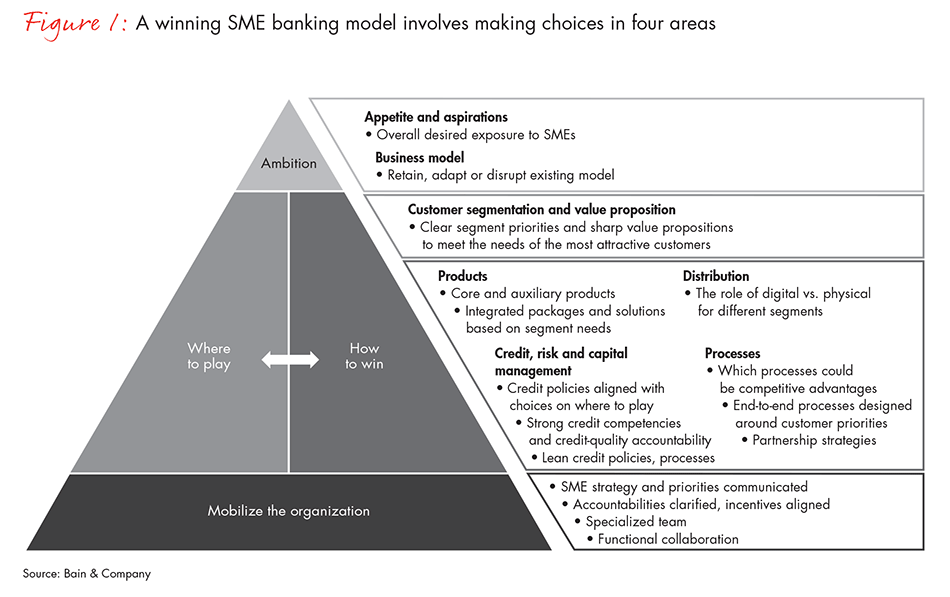
- defining an explicit ambition in serving SMEs;
- choosing where to play, defined by segmentation model, customer priorities and value propositions;
- taking a deliberate approach on how to win in each chosen market, rather than a one-size-fits-all approach to products, solutions, distribution, end-to-end processes and credit risk management; and
- mobilizing the organization for change.
What’s your ambition?
The fundamental choices in setting one’s ambition lie along two dimensions. The first dimension of choice involves how restrictive or expansive a bank will be in participating in SME markets. A bank could reduce or expand its exposure overall, make selective investments in current positions, or at the extreme, exit the business altogether.
The second dimension of choice involves the extent of disruption to the current business model. A bank could adapt select elements of the current model and set about improving them; reinvent the model by, for instance, adding new regions or significant partnerships; or disrupt the model by, say, moving from a branch network to a largely online model.
Incumbent banks naturally incline to the status quo, making only gradual changes to their SME model and relying on cost cutting as a path to eventual profitability.
But continuing to run a business as has been done for the past decade or two is unlikely to yield much better results. More likely, building a sustainable model that’s both profitable and prudent will require more radical measures. It’s useful to ask what the business should look like five years hence and work backward—which might mean departing from current choices about customer segments, products and distribution patterns.
One European bank recently defined an ambition to reignite its SME business. It aims to grow the overall exposure substantially and to reach leadership positions within select SME segments such as healthcare and professional services, more than doubling overall market share in the process. The first phase of the plan will rely heavily on investments in high-touch, branch-based advisory services tailored to the needs of the target segments.
Where should you play?
Once a bank has defined its ambition, it is ready to make deliberate choices about customers, products, distribution and value propositions. In particular, a bank will need to address these questions:
- How should it segment the customer base, and which segments should it emphasize over others?
- What value propositions should the bank offer to the different segments?
A broad-based portfolio, covering multiple segments with a full product offering, is increasingly vulnerable to digital competitors pursuing slices of the market. Banks with a catch-all portfolio could end up as utilities with high costs to serve and slim margins on credit.
Rising out of the utility mire starts with a deliberate, pragmatic segmentation of customers. While many banks do apply segmentation models to the SME portfolio today, by size or industry criteria, and some even select a few segments as forming the core of the portfolio, only the most advanced banks consistently follow through with the implications of segmentation and prioritization for their organization.
Advanced segmentation starts with decisions concerning whether to apply one focused suite of products to all customers or to pursue tailored strategies and value propositions for certain or all segments (see Figure 2).
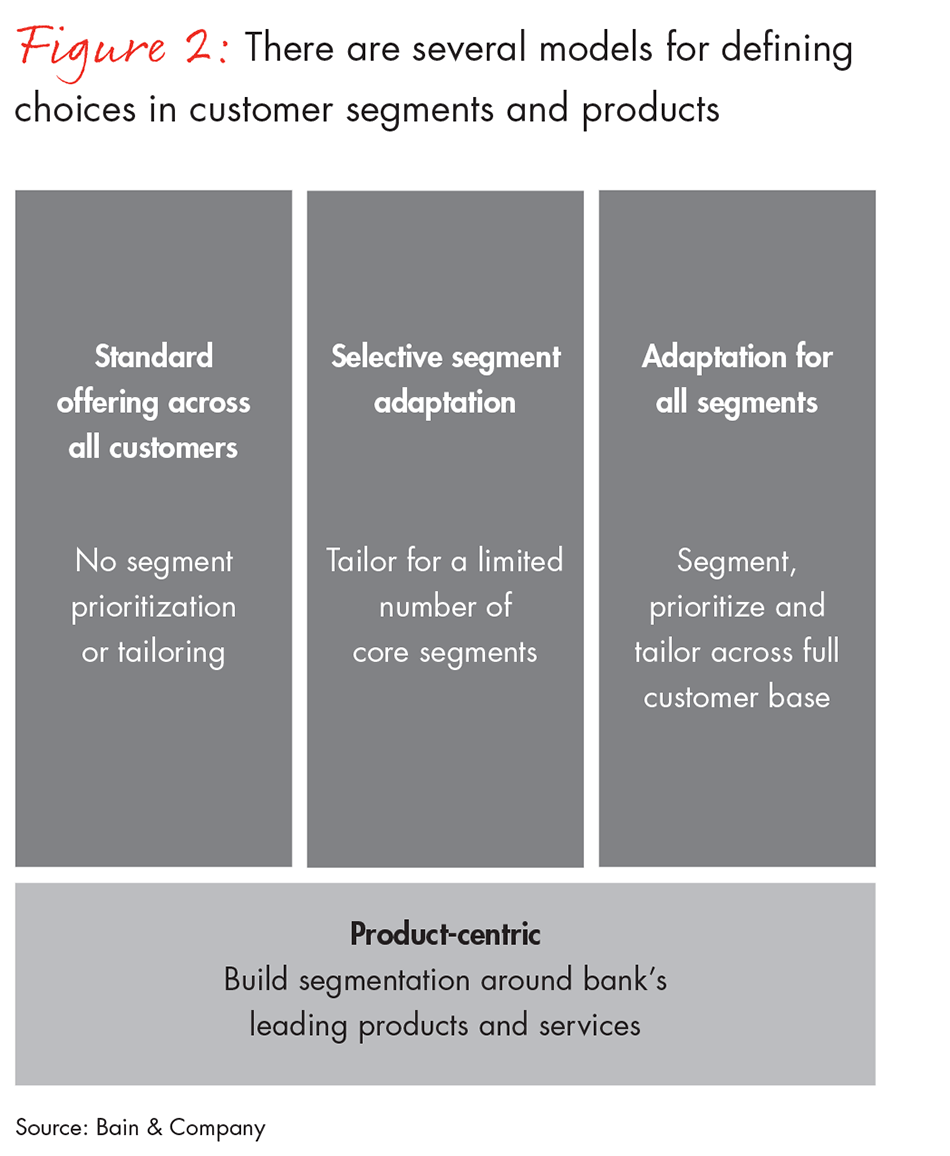
One option consists of one broad multiproduct suite across all segments, with standard pricing and a simple distribution setup. Most US community banks, which tend to focus on basic core needs, use this model.
For a second group of banks, it will pay to sharpen the focus and fine-tune the offerings, with a tailored offering for specific segments and a standard offering for most of the rest. Rabobank, the Dutch multinational bank, has used its agricultural expertise to carve out a leading position in the US agriculture market, in which it offers collateralized crop financing, livestock lines of credit, equipment leases and other products. Similarly, Bank of America has targeted medical doctors among its special segments, through new-practice financing, equipment financing and practice sale/purchase expertise. In a slightly different take on segmentation, one leading bank in Singapore has a special set of offerings for family-controlled businesses.
A third group of banks will go further to segment the entire customer base, with each segment receiving a tailored offering. JPMorgan Chase has taken this tack, specializing in 12 industries.
Banks can also choose a product-centric model in which they differentiate on the strength of the product. Standard Chartered and HSBC, for instance, have chosen to emphasize international trade finance for SME customers that need it.
Each of these four models could be profitable. The danger lies in failing to commit to one main approach and winding up stuck in a middle ground. Attempting to define tailored solutions for certain segments without having the organization and system scaled appropriately, will result in complexity for which the bank will not be compensated. On the other hand, relying on a standard offering without penetrating sufficiently large customer segments will also keep the bank from realizing its potential.
If a bank chooses to pursue certain target segments, it will need to develop a detailed understanding of those customers’ needs and behaviors, as well as the potential spending and growth attractiveness of each customer (see Figure 3). Winning with small local retailers requires a well-defined, easily understood standard offering that covers basic banking needs as well as distributed cash handling. A larger real estate developer, by contrast, requires specialized advice on integrated financing and risk solutions, and values product expertise in areas such as bond origination, derivatives or asset management. A thorough understanding of these elements, combined with an objective evaluation of a bank’s ability to win within each segment, allows the bank to confidently prioritize its segments.
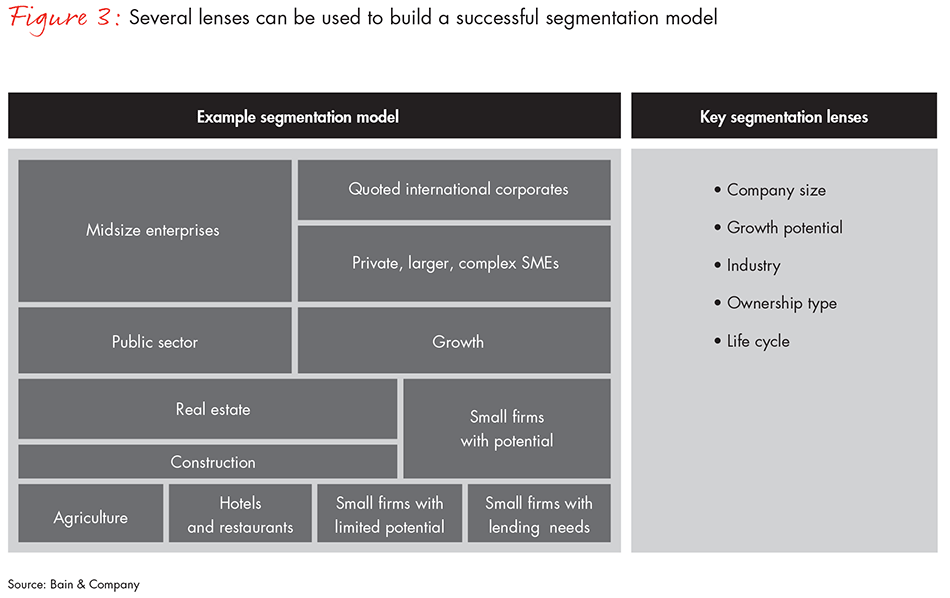
The chosen segmentation scheme then needs to be converted into value propositions that incorporate the bank’s specific business objectives and targets on profitability and expansion or retrenchment for each segment. Decisions will cover several areas, including what products will be offered through which distribution channels, what the credit guidelines will be for each group, and how the bank will market to and acquire customers.
Each choice in shaping the value propositions will have implications across the organization, including what products, distribution methods, skills, resources and capital deployment are required. It’s crucial to identify the bank’s constraints and gaps so that it addresses those and starts earning a return on its investment.
How can you win?
Defining what the bank’s ambition will be and where it will compete leads to the next set of choices about how to win with each segment. This requires a clear-eyed assessment of the starting point, as well as the strengths and weaknesses of the bank’s organization and capabilities.
Determining how to win involves four areas: products, distribution (including the balance of physical and digital channels), end-to-end processes and risk management (see Figure 4).
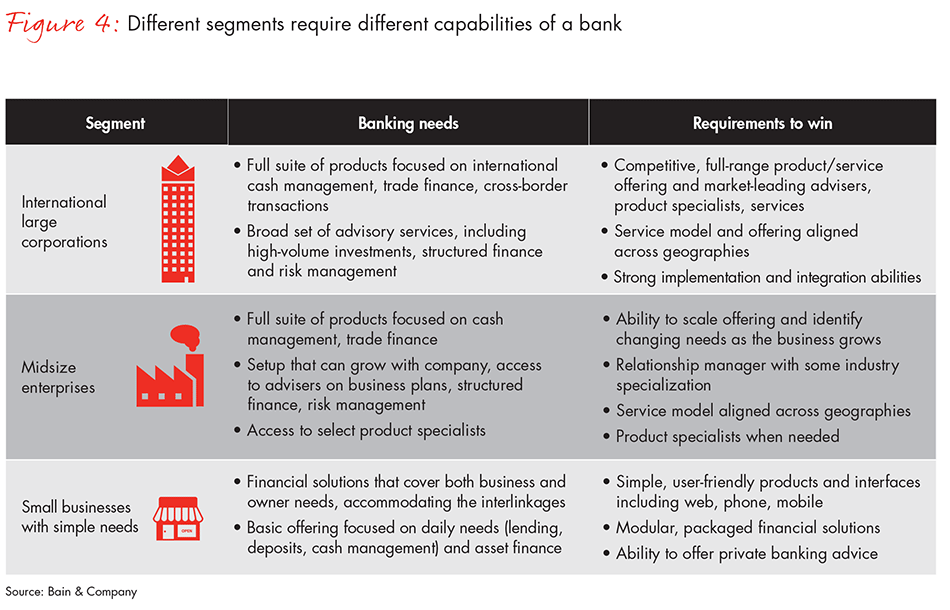
Products. Most large banks suffer from significant and unnecessary product complexity. Customers with similar needs and potential, for example, may be offered widely different products and advice in different regions or even in different branches within the same region. Or specific products may be offered with slight variations on specifications, price and terms. Such complexities make it impossible for the bank to consistently reap the advantages of scale or to accelerate the speed of back-end processes.
To manage product complexity and support cross-selling by the front line, some leading banks are pursuing different approaches for different segments of customers. For small businesses with simple needs, these banks bundle standard products in modular, basic packages. A basic “transactions and payments” package for a retailer, for instance, consists of an account, web and mobile access, credit cards and merchant services.
Larger, more complex SMEs require advanced auxiliary products and advisory solutions. These solutions are critical for realizing the full profit potential of larger customers, yet relationship managers often get overwhelmed by a huge variety of products. Leading banks thus focus and clearly define their integrated solution sales opportunities, presenting them in a menu that’s easily understood by relationship managers. For instance, a “cash management optimization” solution for SMEs with advanced needs could include standard products for lending and deposits, e-business solutions and trade finance, plus advisory services for working capital optimization and liquidity management.
To optimize the product offering, banks should address the following choices:
- Which core products and auxiliary products should be offered to which segments in order to maximize penetration while minimizing complexity? One European universal bank reduced its SME product suite from more than 200 to about 20 well-defined core products and five basic product packages for small businesses by aligning the offering between countries, aggressively pruning it and clearly defining which products and packages the relationship manager should offer each segment. As a result, relationship managers have a far better grasp of each product, cross-selling has improved, and customer onboarding proceeds more quickly.
- How should products be marketed to achieve their full potential? What should modular, basic packages look like for certain segments, and what should advanced, advisory solution sales concepts look like for those segments that merit the customization?
Distribution. Digital technologies are changing distribution models, both because customers have come to expect more online and mobile access and because fintechs have cropped up across the financial value chain. Banks must decide how to balance digital and physical assets at each point of contact with customers—from the awareness stage to information and advice, through to purchase, service and sharing of experiences (see Figure 5).
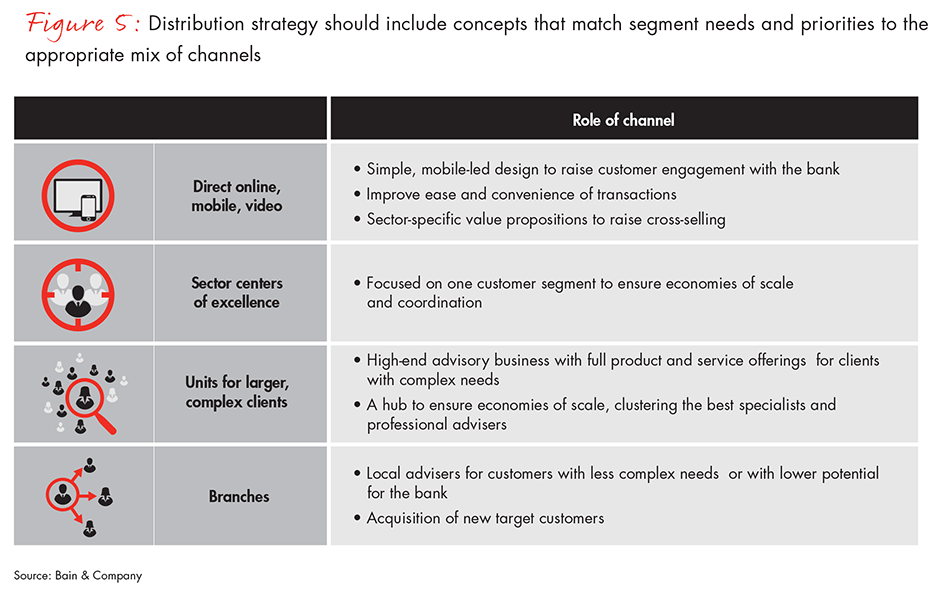
For micro and small businesses, digitalization sharply reduces the total cost to serve by migrating transactions (and thus bank costs) from the traditional branch network to highly scalable online and mobile platforms. That shift enables efficient delivery of standard products and modular packages. For midsize and more complex customers, digitalization changes the game by broadening access to experts and product specialists through online chats and video calls.
Some banks have been directing their investments accordingly to support clear strategy choices. One Nordic bank, for instance, recently decided to focus its core on larger, complex SMEs. It earmarked investments in centralized, high-touch financial centers with dedicated product specialists, senior relationship managers and dedicated credit teams. It moved very small, simple business customers to a cost-efficient direct channel that could function with existing call-center infrastructure.
To determine the distribution strategy and appropriate channel structure, banks should focus their choices on the following areas:
- the role of digital and physical channels in each segment—which interactions should be digital and which physical (for instance, Westpac in Australia has invested in a robust online self-service site as well as easy-to-use videoconferencing so that business owners can speak remotely with Westpac specialists);
- which specific channel setup, capabilities and functionalities are required to win;
- how to maximize return on lower-priority segments through the most efficient setup; and
- the minimum number of different channel formats required, and which segments should be served through which channel concepts.
End-to-end processes. Overly complex processes not only erode banks’ profitability, they also tend to annoy customers. Few banks have optimized their processes end to end. Instead, many processes are plagued by delays and poor information flows at key stages such as credit decisions and onboarding. Responsibilities and decision rights between frontline and supporting credit and operations units tend to be muddled. Among the key processes in SME banking, it’s the credit processes including renewals that remain the most manual and fragmented, resulting in significant errors, rework and low productivity.
To build integrated processes that will delight SME customers, banks should design around the customer’s priorities rather than optimize strictly for internal operations. Digital technologies come into play to improve the customer’s experience along the sequence of touchpoints. And using common IT tools through all of the processes will ensure consistent, automated data.
Several fintechs now offer largely digital credit processes with faster decisions and a better customer experience. PayPal, for instance, has moved into SME lending and offers working capital solutions as an alternative to bank financing, using its access to the transaction history of merchants within its payment system.
Some banks have decided to collaborate with fintechs. OnDeck evaluates a small-business applicant and issues a loan decision in minutes. Its success attracted JPMorgan Chase, the largest US bank, to partner with OnDeck and dramatically speed up the process of providing small loans to SMEs. And Regions recently chose to join online lender Fundation in providing small firms with coordinated delivery of lending solutions. The two companies believe that each will benefit by combining Regions’ brand and retail distribution franchise with Fundation’s streamlined online loan application process and concierge service.
Risk management. The credit crisis exposed flaws in banks’ credit culture and a failure to link their business priorities with their credit strategy. Many banks continue to set their risk appetite and credit strategy without close consideration of the priorities of key customer segments. Typically, the credit organization and frontline units do not work closely together, which leaves credit granting and renewal processes uncoordinated with account planning.
The solution is to transform the credit and risk organization using the following guidelines:
- Establish clear credit policies that align with the bank’s choices on where to play.
- Manage the credit portfolio more actively to optimize for capital efficiency and risk mitigation.
- Build credit competencies and reintroduce credit quality accountability in the front line.
- Make credit policies and processes leaner.
The practical implications of these guidelines include credit planning in the yearly account-planning cycle, building fast-track decision processes for high-priority segments customers, and establishing specialized teams or centers of competence.
UniCredit Bank AG (HypoVereinsbank), based in Germany, has built effective credit risk management by focusing on several of the aspects noted above. Its deal guidelines include thresholds for capital efficiency and whether the deal fits with the bank’s SME strategy. A joint client/adviser approach on clarifying open questions makes the underwriting process more efficient. And rigorous monitoring of client performance provides fast feedback loops to the relevant frontline staff.
Mobilizing the organization for change
Rethinking SME banking will likely require significant changes for many incumbent banks. It starts with senior executives setting the ambition and direction, but winning banks act on other dimensions as well:
- They communicate a clear strategy and priorities all the way down through the front line so that everyone understands the business strategy and priorities as well as what new behaviors are expected.
- They clarify accountabilities, especially among relationship managers, product specialists and the credit organization. And they align performance incentives with the new accountabilities.
- They identify the most competent and specialized SME bankers across different disciplines, and supplement their expertise with whatever new capabilities are required to win, such as digital distribution or Big Data analytics.
- They insist that departments collaborate to build a focused go-to-market program. One multinational bank empowered national specialist teams to serve all of the larger commercial real estate customers in the country and encouraged cross-national experience sharing. The teams were soon motivated to raise their cross-selling and share learnings with colleagues in other countries. The same bank identified its best credit officers and relationship managers for larger, complex SMEs and asked them to codevelop a new annual customer review, including new account plan templates covering the needs of both the credit and sales organization.
SMEs remain a big business for many banks, one that can return to sustained profitability with deliberate, fundamental choices about where to play and how to win. Winning banks will choose their segments and design their value propositions very carefully, doubling down on the best bets and avoiding the areas where they cannot build a competitive advantage.
Martin Tornes, Niels Peder Nielsen, Joe Fielding and Peter Stumbles are partners in Bain’s Financial Services practice, and Stumbles leads the practice in Asia-Pacific. They are based, respectively, in Copenhagen, Copenhagen, New York and Sydney.




